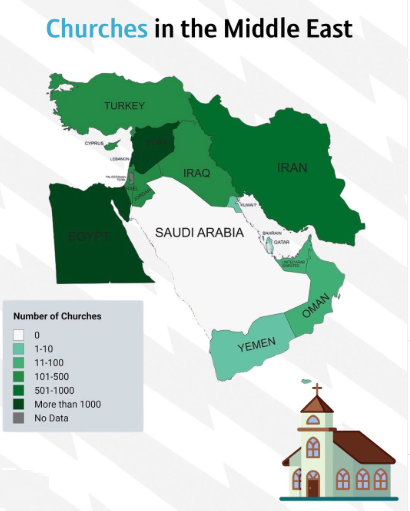Churches in the Middle East Map


Alex Cartwright
Senior Cartographer & GIS Specialist
Alex Cartwright is a renowned cartographer and geographic information systems specialist with over 15 years of experience in spatial analysis and data...
Geographic Analysis
What This Map Shows
The "Churches in the Middle East Map" provides a detailed visualization of the distribution and locations of various Christian churches throughout the Middle Eastern region. This map not only highlights the presence of churches but also reflects the rich tapestry of religious diversity and historical significance that these structures embody in a region known for its complex interplay of cultures and faiths.
Deep Dive into Christianity in the Middle East
Interestingly, the Middle East is often considered the cradle of Christianity, with its roots deeply embedded in the region's history. The map illustrates the various denominations present, including Orthodox, Catholic, and Protestant churches, each contributing to the cultural mosaic of the area.
Christianity was founded in this region around 2,000 years ago, and many of the earliest churches were established in towns and cities that are now significant historical sites. For instance, the Church of the Nativity in Bethlehem, believed to be the birthplace of Jesus, is a major pilgrimage site that attracts millions every year. The presence of churches in this area is not just a testament to the Christian faith but also a reflection of the historical migrations and influences that have shaped the region over centuries.
What’s fascinating is that many of these churches are architectural marvels, showcasing styles that range from Byzantine to Gothic. For example, the St. George’s Church in Madaba, Jordan, is renowned for its stunning mosaics, including one of the oldest maps of the Holy Land. Meanwhile, the historic Armenian Quarter in Jerusalem features churches that stand as reminders of the early Christian communities that thrived in the area.
Furthermore, the map highlights the demographic shifts in Christian populations over the years. Countries like Lebanon have seen a more stable Christian presence, whereas nations like Iraq and Syria have experienced significant declines due to conflict and emigration. This demographic change is reflected in the map, which shows dense clusters of churches in certain areas, contrasted with sparsely populated regions where Christian communities have diminished.
Regional Analysis
Breaking down the map regionally, we can see distinct patterns based on historical, social, and political factors. In Lebanon, for instance, the Christian population remains robust, and this is reflected in the numerous churches scattered throughout the country. The Maronite Church, one of the largest Christian denominations in Lebanon, has a significant presence, with churches like the St. George Cathedral in Beirut being central to the community’s identity.
In contrast, Iraq presents a starkly different picture. Once home to one of the oldest Christian communities in the world, Iraq has seen a dramatic reduction in its Christian population due to years of conflict and instability. The map shows how cities like Mosul, which once hosted a vibrant Christian community, now have significantly fewer churches, with many having been destroyed or abandoned during the turmoil.
Additionally, the Gulf states, while not traditionally Christian countries, have seen an influx of expatriates from various countries, leading to the establishment of churches in places like Dubai and Abu Dhabi. The map indicates a growing number of churches in these regions, reflecting the changing demographic landscape as migrant workers seek places of worship and community.
Significance and Impact
Understanding the distribution of churches in the Middle East is critical for several reasons. First, it highlights the ongoing challenges faced by Christian communities in the region, including persecution, migration, and the struggle for religious freedom. The implications of these challenges can be profound, affecting not only the communities themselves but also the broader social and political landscape.
Moreover, the presence of churches is a significant indicator of cultural heritage and historical continuity in the region. They serve as physical reminders of the long-standing traditions and histories that have shaped Middle Eastern societies. As tensions rise and historical narratives are contested, the role of these churches becomes increasingly important in dialogues about identity and coexistence.
Looking to the future, it is crucial to monitor how the situation for Christians in the Middle East evolves. With rising awareness and advocacy for religious freedoms, there may be opportunities for revitalization of Christian communities. However, the challenges remain substantial, and the implications of demographic changes will continue to shape the cultural and religious landscape of the Middle East.
In conclusion, the "Churches in the Middle East Map" is more than just a geographical visualization; it is a window into the past, present, and future of Christianity in a region that is both historically rich and currently complex. It invites us to reflect on the significance of these sacred spaces and the communities they support.
Visualization Details
- Published
- August 8, 2025
- Views
- 114
Comments
Loading comments...